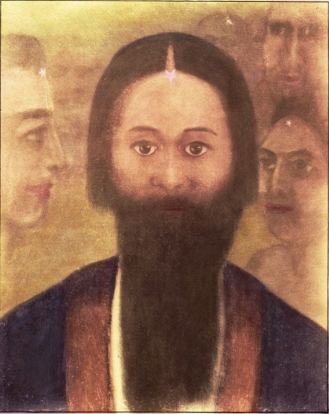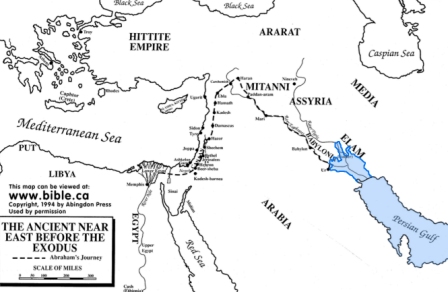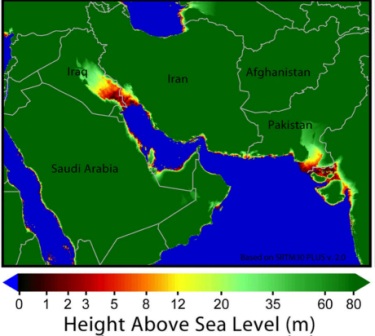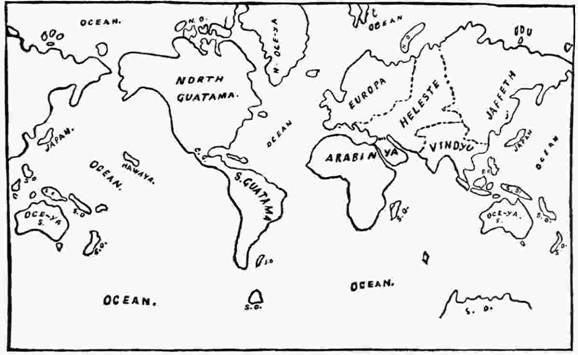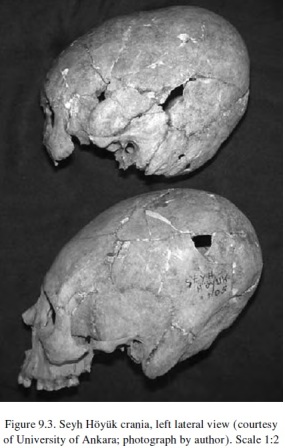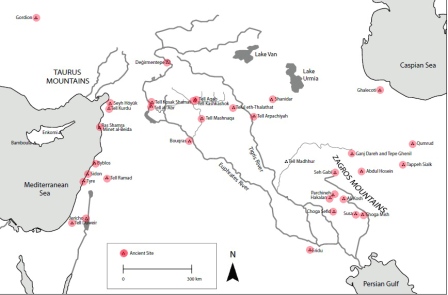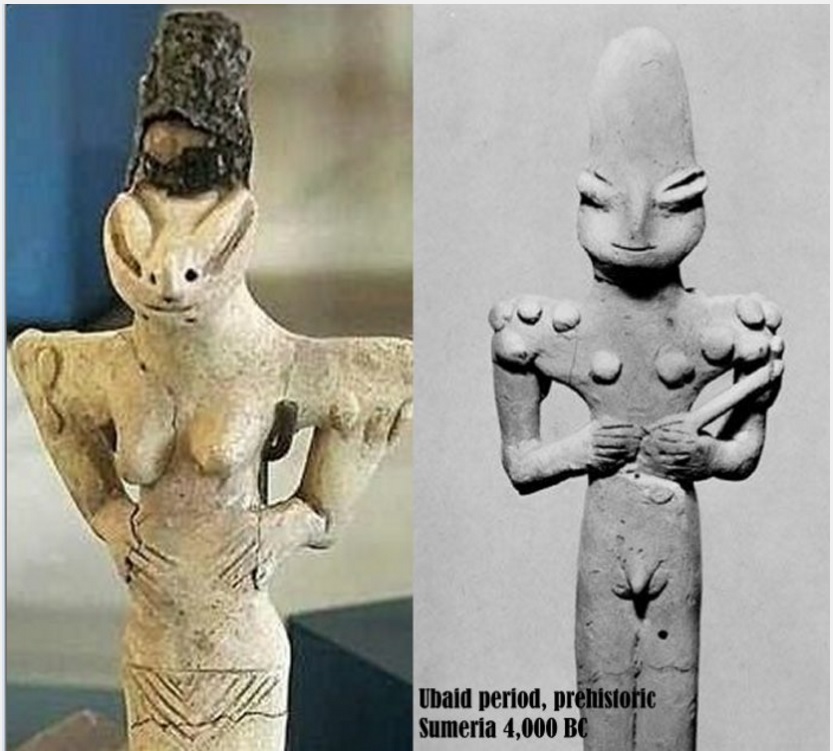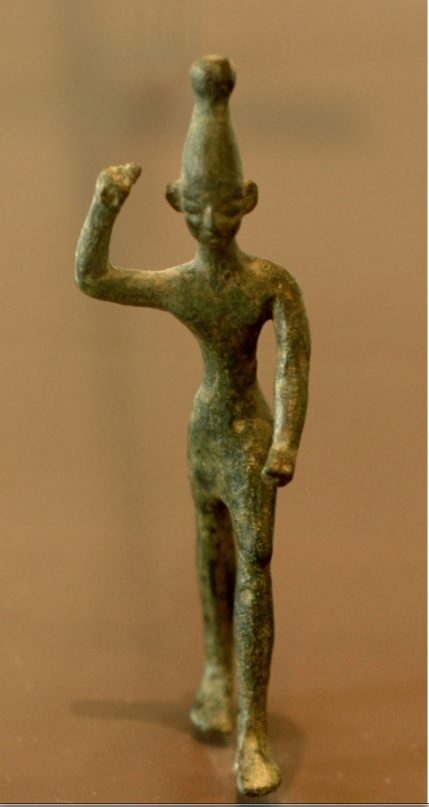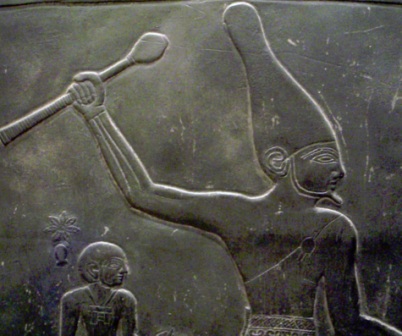Oahspe Study
The True Story of Abraham Part I
Abraham,
Father of Nations ~ Historical fact, myth or legend? Oahspe sheds
light on many personages known to the present generations as no more than myths
or legends. Memory of them is often only saved because some versions of their
histories were passed down in traditional religious texts. Such was Abraham who
appears in the Ezra Bible, but how much truth does the Ezra Bible's version of Abraham's story contain?
Here is a concise summary of the Ezra Bible Account:
"Abraham was the founder of Judaism and the ancestor of both Arabs and the Jews. Scholars believed Abraham lived about 4,000 years ago. The story of his life is told in Genesis, the first book of the Bible. During his early life, Abraham was called Abram. He was born in the city of Ur (of the Chaldees), in ancient Mesopotamia (now Iraq). The people of Ur, like most people at that time, worshipped many gods. However, Abram believed in one God. At God's command, Abram left Ur and traveled westward with his wife, Sarah; his nephew Lot; and other members of his household. After they reached a land called Canaan, (now Israel), God told them the land would be theirs." From The World Book Encyclopedia "ABRAHAM."
According to the record of the Torah, Abraham was the first "Patriarch" who lived circa 2000 bce. But is this date correct? Scholars claim there is no historical evidence that supports Abraham's existence in that period. But just because there is no proof of Abraham in the time frame provided by the Ezra Bible, is this sufficient reason to deny his existence? For, if we consider that Abraham could well have been an actual historical person, despite the inaccuracies of the Ezra bible we may be open to the fact that the Ezra bible story of Abraham is not a complete fabrication (since most myths have some basis in truth, however corrupted that may have become) --- then we may be ready to find out more about this significant ancient person and his times. This series of articles goes a long way in demonstrating that sufficient evidence of Abraham as an actual person exists. It also corrects many errors of the Ezra Bible account and points to the actual historical period in which Abraham lived on earth.
To understand how the Ezra Bible came to misdate Abraham and his times, we refer to some Oahspe Study articles that examine numerous anachronisms of the Ezra Bible: "Who was Thoth" and "The Mythical Conquest of Canaan".
It becomes evident that the authors / editors of the Ezra bible used various devices (both deliberately and unwittingly) as they compiled the written Jewish canon (Miqra or Tanakh) around 494 bce (this date is according to Oahspe). For purposes of connecting and weaving diverse and fragmentary historical literature and narratives gathered from a variety of sources, the Ezra bible editors / compilers often telescoped /compressed periods of time. Not only that, but much of their source material for Genesis had already been condensed and compressed, e.g., the Egyptian records from which Genesis and Exodus were drawn.
So, by the time of Ezra and his cohorts, the narratives of Genesis were already very ancient and their original or earlier details and contexts had undergone various transformations in the retellings. Oral and written accounts, kept in memory among various tribes and nations, by the time of the Tanakh (Jewish bible / Ezra bible) had become represented as allegorical characters such as Adam and Noah who were not historical individuals. And various locations or tribes of people woven into the story also took on forms of individuals. For instance, the genesis story of Adam is told as the first individual man before self-knowledge removed his innocence. But this allegorical Adam is a representation of the first race of man and their transformation into beings with an eternal soul through co-habitation with descended ethereans, who, incidentally, were represented by Eve in that story. This original scenario, having played out some 73,000 years before (Oahspe; Book of Jehovih), had been long lost to mortal memory when it was retold in a form that was adapted to the level of mortal understanding and colored by the agenda of those spirit inspirers who told it. Thus the Genesis story, as copied into the Ezra Bible, was initially told by an Egyptian seer (Who was Thoth) around 3237 bce, some 700 years after Abraham had walked the earth, and long before Ezra and his co-horts collected it from the kings' archives in Egypt and surrounding countries.
Moreover, events or epochs in the Ezra bible are marked by a compressed genealogy of individuals giving the impression of continuity to the stories. For instance, the generations from Adam to the Flood and from the Flood to Abraham are not only unbelievably scant, making it seem as though the first race of man (Asu/Adam) began only 6,000 years ago, but the life spans of these "first" individuals are preposterously long. Not enough though to cover the tens of millennia that passed from the time of the first race of man (Adam), which according to Oahspe was 78,000 years ago, to the sinking of Pan (the Flood) 25,000 years ago. And the time from the Flood to the time of Abraham, according to Oahspe was some 19,000 years!
The Ezra Bible's problems of dates and context create wrong impressions which lead to various incorrect assumptions about Abraham's origins and early life. It picks up the story of Abraham as though he were a lone man among the ungodly. He hears God and obeys, then starts the first monotheistic religion which is carried through the ages by his many offspring. According to the Ezra bible, these apparently multiplied into millions in just 500 years, known as the tribes of Israel. But according to Oahspe, the name Israel comes not from Abraham's grandson, Jacob, but from the union of two ancient tribes Iz and Zerl who become the Izerlites. The ancient name of Iz is still known in the regions from whence Abraham sprung (Northern Syria, Armenia, Turkey, Northwestern Mesopotamia). The numbers of Israelites by the time of Moses did number several millions. However, it did not, could not have, taken just 500 years (this is the Ezra bible time from Abraham to Moses) for them to grow from a few thousand to millions. Both the telescoped / compressed time period of 500 years, and the mistaken assumption that Abraham was the biological ancestor of the Israelites rather than the Rab'bah; or Spiritual / Tribal Father, reduce an otherwise logical historical narrative into a far-fetched mythical tale.
Oahspe shed's light upon the origins of the Ezra bible and also uncovers the True Story of Abraham. The Oahspe account of Abraham is placed in the correct time period and social / historical context. Moreover, evidence of this context can be found in the archaeological / historical record (scant as it is). At the same time, the Oahspe account clears up major misleading particulars about Abraham as given in the Ezra bible.
|
|
Oahspe Portrait of Abraham
Abram was of pure blood, and an I'huan; and the light of su'is had been with his forefathers and foremothers since the flood, and he was large and red, like new copper, and had black hair and long beard, fierce to look upon; but his soul was gentle as a woman's.
Abram could see without eyes and hear without ears, knowing things by the light of God which dwelt in him. For which reason, God chose Abram to gather together the Faithists in Arabin'ya and the adjacent countries, even as he had appointed Po in Jaffeth. First Book of God; 24/8.7, 8.
|
Abraham's natural su-is, i.e. ability to see and hear spirits / angels, distinguished him from Ae'jins, the artificially induced spirit channellers of the king's peoples. Because of this Abraham was known of by petty rulers of the regions where he and his people lived. Further down this page the existence of the historical / archeological evidence of the Ae'jins will evidence the actual time period Abraham lived and walked upon the earth, and the contextual relationship / differences between Abraham and his followers and the petty kings and their people.
According to Oahspe Abraham lived about 6,000 years ago, being 2,000 years earlier than the Ezra bible date. This makes his time on earth around 4,000 bce --- having been born a few decades before the end of Fragapatti's cycle. He was a leaderforth* for the Faithists of Ham and countries thereabouts (as signified by the addition of "ham" to his original name "Abram")** at the dawn of a new cycle (this was the Spe-ta cycle, such cycles can be read about in Oahspe). He was contemporary with Brahma the first and true of Vind'yu (whose identity as a mortal was later replaced with a mythical god in India), and Po of Jaffeth (China) both of whom were leadersforth for the Faithists of those regions (their histories can also be read in Oahspe).
*leaderforth: one who is ordained and inspired by God and his hosts to gather together the Faithists in Jehovih and re-establish them in communities with the doctrines, rites and ceremonies of the ancients.
**The popular etymologies of practically all of the patriarchal names [in the Ezra bible] are explained by synonyms rather than by their true roots, which indicates that their original meanings are unknown or forgotten.... Lexicon Anachronisms of the Pentateuch by www.helpwithbiblestudy.org
Not only are the Ezra bible details of Abraham's story considered by scholars to be pseudo-history, but Abraham's anachronistic placement in the Ezra Bible has also been used to declare Abraham a fabricated myth, since places and events that the Ezra bible names for Abraham's times often fail to match archeological evidence. Yet when Abraham is placed in his true time, i.e., 2,000 years earlier (c 4000 - 3900 bce) we find a different field altogether.
The Ezra Bible's Ur of the Chaldees is a misnomer for Abraham's origin. The name Ur (Or) is an ancient name for Light --- Fire. Its etymology goes back to the first language, Panic, where it mimics the sound of fire. The Faithists of Abraham's time were ancient Zarathustrians whose name for the Great Spirit was Ormazd (Mazd - Master; Or - Light). Ur was an ancient, sacred name among the inhabitants of that region from which Abraham came. So there is no doubt that the later Ur of the Chaldees was neither the first nor the only Ur.
During Abraham's lifetime (4,000 bce) the location of Ur of the Chaldees around 6,000 years ago was below sea level in the Persian Gulf, the coastline would not recede for some hundreds of years yet. Archeological evidence supports a warming event lasting a few thousand years (8,000 to 6,000 years before present), which caused sea levels to rise, peaking a few meters above the ancient coastline upon which Ur was later founded. Thus it explains why there was no significant human settlement in the low lying delta area prior to the Uruk period, whereas, there were numbers of small centers of dispersed small towns / villages of the preceding Ubaid culture in surrounding areas (some unique particulars of which are described in Oahspe as contemporaneous with Abraham). (See comparison maps below indicating extent of the Persian Gulf in relation to ancient Mesopotamian cities and the possible extent of the inundation of the Persian Gulf according to Oahspe's Post Flood Map.)
|
|
Corrected coastlines for 3,500 bce when Ur became the center of the new Uruk culture
500 years before this the land area was still inundated and low lying surrounding areas were marshy and subject to variable sea-tides. Thus the Lower Mesopotamia area could not have been the birthpace of Abraham as is stated in the Ezra bible.
|
|
|
Possible extent of inundation of Persian Gulf from 8,000 bce to 4,000 bce.
"The Holocene Climate Optimum (HCO) was a warm period during roughly the interval 9,000 to 5,000 years BP. This warm period was followed by a gradual decline until about two millennia ago." Wikipedia. This warming led to inundation of the Persian Gulf which had far lower sea levels than at present due to colder climate and greater polar icepacks. |
|
|
Coastlines around 7,000 bce - Fragapatti Cycle - Oahspe
The extent of the Persian Gulf is shown to penetrate much further into the land area covering what later became South Mesopotamia at the lower reaches of the Tigris and Euphrates Rivers. The gulf of that time also shows a clear demarcation of Heleste from Ham / Arabinya. Since Abraham came from Parsie which extended through lower east Heleste, we can see that he came from the North into Canaan, not from the South East where the later Ur of the Chaldees would be situated. |
The Ae'jins of the King's Peoples: The small cities of Abraham's time were essentially city states (often despotic) with influence, alliances and conflicts with neighboring cities, as is found in the Ezra bible regarding the Five cities of the Plains including Sodom and Gomorrah. According to Oahspe, at the time of Abraham, there were many small kingdoms extending throughout the Near East, Par'si'e (modern day Persia, Turkey, Armenia, etc), and Arabin'ya (Middle East and North Africa) whose various kings consulted soothsayers for counsel in most matters such as war; where to find water; religious practices and such. Soothsayers were greatly valued and even during war, they were preserved by opposing sides. Called "ae'jins" (from which the Arabic word jinni, djin came, which means lower class spirit), they owed their talents to having had their foreheads compressed / flattened in infancy. This practice allowed them spiritual sensitivity (but at the cost of losing judgment since the frontal lobe could not develop) by which they could become channels for spirits.
Frontal lobes have been found to play a part in impulse control, judgement, language, memory, motor function, problem solving, sexual behavior, socialization and spontaneity. Frontal lobes assist in planning, coordinating, controlling and executing behavior. People who have damaged frontal lobes may experience problems with these aspects of cognitive function...wikipedia
Thus the ae'jins were not like the rest of the populace but rather a resource, a beneficent bestowal of the gods, much as a library or institution of learning, to be guarded and cared for by those who benefitted from their services.
This ae'jin-dominated culture existed hundreds of years before and endured some hundreds of years after Abraham. Its time frame fits into what anthropologists / archeologists call the Amratian culture or Naqada I period in Egypt, and the Ubaid culture in Mesopotamia which ended with the ascendancy of Ur and the Uruk culture. A unique feature of the Ubaid culture which extended from what is modern day Iran to Turkey, was a widespread practice of a severe form of head compression which deformed the head and brains beginning in early infancy:
|
|
Early-Neolithic deformed skulls:
These skulls are common from about 5,000 to 7,000 BC in the areas that would later become Iran and then diffusing out into the surrounding territories. Many skulls in the same time period from Iraq, Southern Turkey and Syria are also deformed but not usually so severely. In later historical time many of the Iranian-speaking nomads of Central Asia continued the tradition and eventually the trait was introduced into Europe from the East by the invasions of the Huns....Wikipedia |
Cranial Deformation in the Ubaid Period:
Places where artificially shaped skulls were found: Eridu (Sth Mesopotamia, Chofa Sefid (South West Lowlands Zagros Mountains), Choga Mish, Seh Gabi, Qumrud, Tell Arpachiyah, Telul Eth-Thalathat, Tel Madhhur, Seyh Hoyuk, Degirmentepe
What is special about circumferential headshaping in the fifth millennium [5,000 - 4,000 bce] is its wide distribution in Ubaid and Ubaid-related contexts, ranging from Mesopotaimia and Iran to eastern Turkey....[Choga Sefid: 6 skulls, Ali Kosh: 3 females out of 14 inhumations, Choga Mish 1 female of 2 skulls]
The widespread use of circumferential headshaping in the 5th millennium seems to largely overlap with material culture traditionally linked to the Ubaid phenomemon....
The subtypes of circumferential headshaping known from Ubaid contexts have their origins before the Ubaid period, most likely in the Neolithic of Iran....
Thus according to current knowledge, it is from the eighth millennium [8,000 - 7,000 bce] onward that the kind of circumferential-type of headshaping present in later Ubaid contexts emerges, at sites as Gnj Dareh, Ali Kosh, and Tepe Abdul Hosein. These sites are all located in Iran. In the southern Levant the earliest reported evidence for circumferential headshaping known to the author comes from the site of Byblos, where the skeletal remains are dated to the second half of the fourth millennium [3,500 - 3,000] bce. In Anatolia the earliest evidence for circumferential headshaping known to the author derives from Prygian-period Gordion, although other types of headshaping are known from earlier sites....
After the fifth millennium [5000 to 4000 bce] the widespread use of circumferential headshaping seems to wane....only single sites with evidence of circumferential headshaping are known from later periods including Byblos, Cyprus, Prygian, Gordion....not every [skull found] was modified, and not to the same extent....
The earliest forms of headshaping securely attested to in the region are the anterior-posterior in Cyprus and Aceramic Jericho and circumferential types in early Neolithic Iran.
Dated c.7,500-5000 BP Choga Sefid. Remains of three individuals were recovered.....all were affected by circumferential type headshaping....the skulls show extreme cranial deformation...Choga Mish 4,500-4,000 bce. Cranium displays clear circumferential type head-shaping....
Extracts from Ubaid Headshaping: Negotiations of Identity through Physical Appearance, Kirsi O Lorentz Beyond the Ubaid Culture Transformation and Integration in the Late Prehistroric Societies of the Middle East edited by Robert A Carter and Graham Philip.
|
Archaeological sites of found head-shaped skulls from the Ubaid period |
|
|
Deformed skulls due to infant head shaping were usually found in small cemeteries, sometimes with non-deformed skull remains, sometimes all the skulls deformed. Consequently archeo-anthropologists believe that headshaping was widespread during the Ubaid period, and that a high proportion of the population were subject to it in infancy by their parent(s). But these researchers fail to consider any effects that headshaping would have on brain function (because ergo, the culture existed and appears to have functioned as well as other comparative cultures) . It is, however, common knowledge today that any damage to the frontal lobe reduces the ability to think and function normally. So it is not likely that head compression was universal, but rather, in order to maintain a supply of ae'jins, significant numbers of children were selected for headshaping, perhaps even touted to parents as a privilege, or as mandatory for at least one child in a family to undergo the treatment. According to Oahspe Ae'jins had high status, second only to the king, and being a most valuable resource with connection to the spirits, their burials likely commanded special and exclusive attention and preferred burial sites. We see a parallel in the later Ancient Egyptian culture of Pharaohs who were believed to be directly related to the gods and also receiving grand burial rites and locations.
|
|
Two figurines from the late Ubaid - early Uruk period:
Both figures feature elongated compressed skulls. The faces also appear deformed particularly the eyes and receding chin. Could it be that severe pressure not only pushes the bones and brains upward, but also down and outward, pressing against facial features, including the eyes which appear to be bulging under slitted lids? Compare with photos below of modern day head compression among infants of an African tribe around the mid-twentieth century. |
|
|
|
|
El Ancient Canaanite God (left) and Hedjet (White Crown) worn by Narmer c. 3100 bce
Both figures follow on the heels of the Ubaid period --- do we see a reflection of the elongated head of the ae'jins in these two heads? El maintains the bulging slitted eyes also. The headdresses conform to the elongated head-shaped skulls widespread in the Ubaid period which ended some 500 years prior to the first known depiction of the "hedjet" in Nubia. It is the earliest form of ancient Egyptian crowns worn by "God Kings". Both of these "crowns" likely hark back to the ae'jins. The top knot likely emphasizes the top regions of the brain which are associated with the perception of spiritual things.
|
|
|
|
|
Mangbetu Tribe in Northeastern Congo practiced headbinding, called Lipombo. This tradition was prohibited by French colonizers in the 1950s. The Mangbetu have a distinctive appearance --- especially noticed in infants and children are bulging slitted lids. With even more severe head binding as practiced in the Ubaid culture, such features may be far more accentuated, as seen in ancient figurines depicted further above. |
Industry and Lifestyle in the Ubaid Period
Hundreds of years before the rise of Ur (which coincided with a widespread spike in knowledge of arts and sciences and a corresponding diminishment of ae'jin repositories), the older culture of Abraham's time was being replaced by increasing master and guild resources in both knowledge and skills, which stimulated a growing trade in high quality manufactured goods as well as contributed to a burgeoning urbanization of populations. Over the course of hundreds of years such civil developments would reach their peaks. The Ubaid period though was not without various small scale industries and trade including pottery and basket and fibre weaving, flax and wool, butter and cheese and seasonal grain and seed crops. It is interesting that in the Oahspe retelling, Abraham mentions some of these occupations, which confirms that Oahspe provided information about Abraham's time period which was yet to be uncovered by archaeologists decades later. For instance, until recently it was believed that wool from sheep was not used until the Uruk period some 500 years later, but more recent analysis of archaeological evidence gathered from the Tels of Northern Syria and Northern Mesopotamia indicates that wool was gathered and spun from domesticated sheep from around 4,000 bce but not before the fifth millennium (5,000 bce). Although evidence of domesticated sheep does go back to even earlier times, they were most likely used for wool and milk and not for subsistence on their flesh since that would have required very large flocks. Due to the low fertility of sheep, and the arid climate, domesticated sheep could not be sustained in such large flocks in any concentrated numbers. Oahspe reveals that flocks of goats were herded by the Par'si'e "Shepherd Kings" during Fragapatti's cycle from around 9,000 years before present. And even before then, some 15,500 years ago, the lost tribes of Ghan Faithists travelling from Ham to Shem to Jaffeth and Jaffeth to Shem to Ham (which became the Silk Road in much later times) during the cycle of Thor, first tamed the wild goats of Par'si'e for their milk when they became separated from their fellow travelers in the land of the cannibals, and being vegetarian they could find no vegetable food in the sparsely vegetated land.
Archaeo-zoologists have identified wool bearing sheep...from the fourth millennium bce...the existence of wool-bearing sheep is documented in early clay tablets of the third millennium bce...A growing emphasis upon the exploitation of wool during the fifth millennium [Spindles diminishing in size for spinning flax or wool fibers found in Tel Kosak Shamali and Telul Eth-Thalathat II in from 1956 to 1964 dating back to the 4th and 5th millenniums bce] supports a gradual increase in the raising and exploitation of wool-bearing sheep in the fifth and early fourth millenia bce. [Scholars argue] that the major shift from the use of flax to that of sheep's wool caused significant economic and social transformations and an accompanying re-organization of land exploitation, patterns of ownership, labor roles and social relationships, all of which are germane to the development of complex societies during fourth and third millennia bce....
Extract from The Development of Wool Exploitation in Ubaid-Period Settlements of North Mesopotamia by Hiroshi Sudo; Beyond the Ubaid Culture Transformation and Integration in the Late Prehistroric Societies of the Middle East edited by Robert A Carter and Graham Philip.
Abraham and his people herded flocks of sheep, (as did the Par'si'ans before them with supporting archaeological evidence for sheep herding in the region going back to the ninth millennium bce) and indeed, according to Oahspe they made butter, cheese and wool, as well as growing grain and flax And for the vegetarian Faithists "fishing" was not considered an occupation, although some members of the community of Abraham's followers did indeed fish, as we can gather from Oahspe:
Oahspe; First Book of God: 24/12.16.
|| Let all men render to the Creator his creations, for they are Jehovih's. After that, Abraham said: Some men grow flax, some wool, and some corn [grain]; but the seasons do not bring forth alike to all. Others spin and weave; and others make butter and cheese. And yet this also happens: One man is strong, another weak; one rises with the sun and toils all day; another sits on the bank, fishing .||
Life-giving Water in the Desert
Since Abraham and his people wandered with their flocks of sheep across an arid land were surface water was scarce, it was important to access subterranean sources. To find where to dig a well then was an important skill. While modern seismology and geological data may help us today, it was not so in those days, so anyone who could predict or "divine" the right place to dig a well would have been considered capable of "divine" knowledge. While such questions could be put to the Ae'jins, there was no guarantee that the spirits channeling through them could answer. Abraham, however, being a natural su'is and whose attendant spirits were high grade servants of Jehovih, had no difficulty in revealing the best places to dig wells.
One place mentioned in Oahspe where Abraham camped was Jireh. It appears that this is where the later city of Jericho was built. Many springs made this a place of camping and eventually a permanent settlement. According to archaeologists, while there are some signs of sporadic small settlements from 9,000 bce onwards it was not until around 2,600 bce that the bronze age city of Jericho was built. Typically there was access to deep wells within the perimeter of the city walls.
Oahspe reveals that Abraham not only dug many wells, but that he and his descendents would continue to dig wells and plant gardens wherever they went. In turn these good places would be appropriated by others who then built permanent towns around the wells. These details are supported in the archaeological record for there is no indication of any permanent settlements in the arid Canaan region before Abraham's time, but within a few hundred years the numbers of towns multiplied, typically built around / near one or more well situated wells.
First Book of God; 24/12.21-26.
|| Abraham asked concerning lands. God said: Consider the way of your God. Did I go to the king and to the rich man and say: Give me your sons and daughters? No, but I went to those who were despised by the king and the rich, and I said: Come! And they came.
And when you came here, did I say: Take the king's lands, or the rich man's? No, but I led you to that which was neglected and waste in the eyes of the kings' peoples, and I said: This is your inheritance.
It is sufficient for you and your people to buy burying‑places for the dead, which shall not be disturbed. But neither buy nor sell any other lands.
And after your people have improved a place, and a king comes against you, saying: I will have this land either by purchase or by battle, you shall say: No, neither by purchase nor by battle, shall you inherit that which is Jehovih's. But if you desire the land, then I will give it to you without money and without battle.
And it shall come to pass that my chosen shall be driven from place to place, where I will lead them; and they shall make the waste lands bloom like gardens, and the deserts yield ample harvests; for they shall dig wells, and till the soil, and prove to the nations of the earth the glory of my works.
And they shall be cut down, driven away and scattered, but I will come and gather them together. Their places shall be inherited by idolaters and worshippers of strange Gods, who will build mighty temples. But my people shall not build that which endures in stone, wood or iron; for they shall go from place to place, proclaiming me and my works; but where they have been, there shall be nothing left on the earth to show their labors. ||
And Abraham, it will be shown, would play a great role in the shaping of man's culture in ways that are not yet discovered by archaeologists or anthropologists (who still think that essentially all head compression was done for "decorative / cosmetic" purposes). For example, the rites and ceremonies of the masters and guilds were based on the core of the religion taught by Abraham. Yet, rather than being the discoverer / inventor of a new religion, Abraham belonged to a long established traditional of FAITHISTS IN THE ONE GREAT SPIRIT, descended from the original Zarathustrians established some 3,000 years prior, at the dawn of Fragapatti's cycle (c. 7,000 bce). But before we study Abraham's religion there are still some important things to straighten out!
Abraham's Character
It is time to clear up, once and for all, the malicious fabrications about Abraham that found their way into the Ezra bible, which are still unwittingly repeated by descendents of his own people to this day!
First Book of God; 24/11.19-32.
In those days Arabin'ya was divided into many kingdoms, some having one city and some two, and some as many as six cities. And they were constantly at war one with another, and the victors always changed the names of the kingdoms. The largest and most powerful always called itself the Sun Kingdom, after the manner of the Par'si'e'ans (Persians).
Men and women of learning dwelt in the Sun Kingdom, and they had tablets and books, and maps relating to heaven and earth, all of which were kept in a library; and in the summit of this same building was an oracle for consulting with the spirits, called Lords of heaven.
For which purpose, a man or woman, whose head had been flattened in infancy, sat by a table covered with sand, upon which the spirits wrote with the finger. And this person communing with the spirits was called Ae'jin in the South Arabin'yan language, and was next to the Sun King in rank. Now, no matter what wars took place, the library, the temple of the oracle and the Ae'jin were sacred, and never suffered harm even between enemies.
The kings kept scribes whose business it was to write and translate, and to keep the records of the kingdom. Besides these, there were gatherers of news, who held the second rank of scribes.
Now when Abraham and his people came into Arabin'ya, especially into that part later called Egupt, the matter was entered in the records of the different kingdoms, with special reference to Abraham professing to hear the voice of God, for he did not have a flat head, and moreover, had good judgment of his own, quite unlike the Ae'jins in the temples.
But because Abraham gave no counsel regarding war or earthly gain, he was not favored by any of the kings, and allowed to go his way unmolested.
When Sodom and Gomorrah were destroyed, the kings' people heaped the blame on Abraham's head, and enemies rose up against Abraham in those regions.
And they also accused him of attempting to burn his son, Isaac, as a sacrifice to his God, after the manner of the heathen of old.
And they accused Abraham of being the father of Ishmael, by his servant maid, and of driving Hagar and Ishmael away to Par-an after he tired of her.
And these accusations, and many more of equal wickedness, were heard of by the news gatherers, the scribes, and they wrote them down, not knowing in truth what they were doing before God (recording lies as historical facts); and so, their records were entered in the libraries of the kings of Arabin'ya, especially in that land later known as Egupt.
Abraham perceived these matters, and he wept before God, saying: Alas, O God, if only I had great learning and could write my record truthfully before men! God answered him, saying:
Your faith being in Jehovih, it is well with you. In thousands of years, one Ezra shall send his scribes into these countries to gather news, even as the kings of this day do. And his scribes shall translate from these records, with all their errors and falsehoods, and Ezra shall publish the matter as the history of THE DELIVERANCE.
Abraham hearing this from God, bowed down his head and wept, saying: Your will be done! And God comforted him, saying: I am the Light and the Life!
The God of heaven and earth will come afterward and render the records of your life, which are not dead, but of life everlasting. And so, since your people shall be honored by even that which shall come from their enemies, how much greater will their glory be, when God of heaven speaks for you and them!
First Book of God; 24/13.19 - 21.
God said: Behold, there is a time to clear up all things, present and past: Were Abraham father to Hagar's son, Ishmael, and had he been true to the law of sacrifice among the heathen, then, Ishmael, being first born, would have been chosen for the burnt offering.
In which matter the Ezra Bible is shown to be false before Jehovih, in regard to Abraham, Ishmael and Isaac, and the burnt offering also.
Which words were not my [God's] words, nor the words of my angels, but the words of the Eguptian record.
Thus we find that the story of Abraham in the Ezra bible is rife with falsities that originated from those who hated or envied him. According to Oahspe, the original Zarathustrian religion did not have child sacrifice and it also ruled against incest between blood relatives. Nor did Zarathustrians have more than one wife or husband; thus the story of Hagar standing in for Sarai to bear Abraham a son is also false and is shown to be so in Oahspe, as is the eviction of Hagar and her son into the desert---nothing but another lie upon a mountain of lies.
So as is shown in Oahspe, the Ezra bibles version of Abraham submitting to an order to sacrifice his own son to a god is untrue. As well, the Egyptian fabrication that Sarai and Abraham were half brother and sister is a sham. This non-fact was woven into a couple of fictitious incidents whereby a king of "Egypt" (Egypt did not exist at the time, another anachronism of the Ezra Bible) and a King of the Philistines (which nation did not yet exist either) were both duped by Abraham and Sarai in a "marriage deception". So the tale goes that both kings supposedly paid off Abraham and Sarai handsomely in animals and treasures, thus giving the appearance of Abraham growing rich due to trickery and at the expense and generosity of the kings. Not only that, but apparently a "cunning" libel is hard to pass by for some tale-tellers because the same story is repeated for Isaac and Rebecca with the same Philistine King! The over usage of this canard greatly diminishes its credibility, the editors of the Ezra bible however did not seem to notice. More likely they did not consider it in their purview to censor the material they gathered, rather they were to compile and present it in a flow of written narratives.
It is a relief to find that the Jewish encyclopedia considers all three stories to be instructive analogies rather than historically accurate:
The Analysis of Wife-Sister Narratives:
The Jewish Encyclopedia's article "Sarah" notes that "the story of Sarah's life, brief and incomplete as it is, presents nevertheless curious repetitions, e.g., the incident with Pharaoh and a similar incident with Abimelech (Genesis 22:10 and Genesis 20:1)."
Striking parallels occur between the tales of Isaac and Abimelech and Abraham and Abimelech, both of which involve the names of Gerar, Abimelech, and Phichol, all taking the same roles in the story, with Phichol and Abimelech making the oath to the Patriarch at Beersheba, which was consecrated to the Israelite deity, and with Abimelech previously coming to realise that the Patriarch's wife is just that. The Egyptian story on the other hand resembles an abridgement, with the later treaty cut out of the story, and on the whole appearing in its own context to be an odd irrelevant aside. As they currently stand in the Torah, it appears that Beersheba is named for the first time twice, for the same reasons, consecrated for the first time twice, and that there are either two consecutive Abimelechs who are each king of Gerar in turn, and each have a captain of the guard named Phichol, or that these are the same long lived individual, with each instance of Abimelech correcting an earlier identification of the Patriarch's sister with his wife, and desiring to make a non-aggression pact covering multiple generations with the Patriarchs at Beersheba.
According to the Jewish Encyclopedia, the recurring story has a unified purpose:
"From the point of view of the history of culture these episodes are very instructive. But it is not very probable that Abraham would have run the risk twice. Moreover, a similar incident is reported in regard to Isaac and Rebecca (Genesis 34:6-11). This recurrence indicates that none of the accounts is to be accepted as historical; all three are variations of a theme common to the popular oral histories of the Patriarchs. That women were married in the way here supposed is not to be doubted. The purpose of the story is to extol the heroines as most beautiful and show that the Patriarchs were under the special protection of the Deity."
Neither is Rebecca a blood relative of Abraham or his son Isaac, as incorrectly recorded in the Ezra Bible, but according to Oahspe she is a niece through marriage:
First Book of God; 24/13.13:
|| And so [Rebecca] gave as she said; and when she had finished, the overseer said to her: Who are you? And she answered him, and he perceived she was Isaac's niece by Abraham's father's second wife, but of no blood kin... ||
And Hagar of her own accord chose to leave Abraham and his people, due to her jealousy of Isaac for Ishmael's sake, since Abraham now had a rightful heir by blood. And she was not abandoned in the desert to die with her child as implied by the Ezra bible:
First Book of God; 24/11.14-18:
|| And when Hagar saw that Sarai bore a son, Hagar became jealous for Ishmael's sake, and she wept before Abraham. Hagar said:
I am a South Arabin'yan [Egyptian] woman, and I left my people for you. Behold, I am not favored by your God. Abraham said: Have I not been like a father to you and your son? Truly, when all people reviled you because you had a child in maidenhood, laying it on me, I did not deny you, nor justified myself before the kings' people, suffering these things for God's sake, and yours, and your child's.
Do not complain, then, against my house, my wife, or my son, Isaac; all things are of the Creator. And so Hagar was pacified for a season, but then returned to grief and jealousy, and finally resolved to depart away from Abraham's house.
Then Abraham said to Hagar: The matter lies with you. If you go, I will give you, according to the custom of the Arabin'yans, a jug with water, and bread and blankets.
So Hagar persisted, and Abraham provided her, and she departed, taking Ishmael with her, and she went into Par‑an and dwelt there....||
We also have to redress the lies of incest regarding Lot and his daughters. Lot (the elder) was also Zarathustrian by religion, so not only he, but his grown "married" daughters would have known the incest taboo. Lot's story in the Ezra bible begins with a badly constructed narrative of his role as good host to visiting "angels appearing as men", offering to throw out his own (married) daughters to an ugly crowd of men claiming his daughters were virgins. The incongruence of married women being virgins apparently bypassed the editors of the Ezra Bible (but perhaps the insinuation in this story is that Lot lied to the crowd, however, that is not congruent either, since the remarks of the crowd indicate they knew him and the comings and goings of his household, and so would have known the marital status of Lot's daughters. So perhaps the tellers of this tale are thus branding Lot a liar too, since Abraham and Isaac were branded as such by those who bore false witness against them). Moving along, the Ezra bible scene switches to Lot alone in his cave with two daughters because their mother was turned into a block of salt (and those who looked upon the face of the Gorgon turned to stone, same fable different context) --- the mood having been set by the usual drunkenness theme that is somehow meant to excuse bad or out of character behavior, as is also shown in the Ezra story of Noah when he supposedly curses his own son's son and descendents (not true of course, since we know that Noah was a representative person of the I'hins who survived the submergence of Pan known as the Flood). In any case what righteous father (as Noah was supposed to be in the contrary Ezra Bible Flood story) would curse his own descendents to servitude to his "good" brothers and their descendents. Oahspe tells us that Lot was also of the same Zarathustrian faith as his brother Abraham. He was also the head of his household with married daughters with their families. There is no reason Lot's wives would have left the condemned city without their own families, for which reason it is very likely that the slander of incest was another made up attempt to denegrate the non-heathens who would not participate in the degenerative cultural and religious practices of the idol worshippers.
Thus we find that much of the Abraham story in the Ezra bible lacks historical accuracy and is mostly made up of nasty tales of slander, conflicts and payoffs by "just and generous" kings casting Abraham and Isaac as opportunists getting rich and taking advantage of unsuspecting hosts. We find that the sacrifices of animals and even willingness to kill one's own child are attributed to Abraham. Yet in truth, being commanded not to kill, he practiced neither in thought nor deed. And this is proved in the negative, for, the Faithists, covenanted to high ethics as they were, certainly would not have gathered around such an unsavory character as the Ezra bible portrays. Instead, many, many people came to live alongside Abraham; for, like Moses he became the leaderforth of the Faithists. But among those attracted to him were others who were not yet Faithists, nor yet capable of covenanting to the brotherhood of Faithists. And these, though having descended from Zarathustrians, but not having covenanted, did not fulfill the Zarathustrian laws that required vegetarian diet; for it was unlawful to kill. Sacrifice of animals was a practice of the flesh eaters not those of the original Zarathustrian faith.
Thus, we find the contrived controversy over who was to be sacrificed, Isaac or Ishmael, to be a salaciously false red herring to cover up the fact that in any case whatsoever, Abraham would never have agreed to sacrifice (kill) any human being! This of course means that the tales of his getting involved with petty wars between petty kings and dealing with "allied" kings is more fabrication. As a servant / slave in a king's household as a youth and running away to freedom, Abraham knew well to steer clear of kings. And kings, being kings over small cities separated by large expanses of wilderness, had little resources or inclination to become involved with him either, other than perhaps to envy his wisdom and apparent divine protection.
Continued in Part 2: The Religion of Abraham.
All Oahspe references are from the Standard Edition Oahspe of 2007
●
GO TO NEXT
ARTICLE:
The True Story of Abraham Part 2
